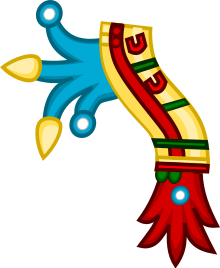Difrasismo is a term derived from Spanish that is used in the study of certain Mesoamerican languages, to describe a particular grammatical construction in which two separate words are paired together to form a single metaphoric unit. This semantic and stylistic device was commonly employed throughout Mesoamerica,[1] and features notably in historical works of Mesoamerican literature, in languages such as Classical Nahuatl and Classic Maya.
The term was first introduced by Ángel María Garibay K.[2]

For example, in Nahuatl the expression cuitlapilli ahtlapalli or in cuitlapilli in ahtlapalli, literally 'the tail, the wing', is used in a metaphoric sense to mean 'the people' or 'the common folk'. The Aztecs' term in xochitl in cuicatl ['flower and song'] could refer to any artistic endeavor in general and the effect of the divine force teotl.[3] The pair in tonan, in tota ['our mother, our father'] (which in classical Nahuatl is the only gender-neutral way to refer to a "parent") is often part of an invocation to a high god.[4] The atl-tlachinolli ['water, burnt-earth'] or atlachinolli pairs the elemental opposites of water and fire (each a force for both life and destruction) into a single symbol of war.[5]
See also
Notes
References
- Andrews, J. Richard (2003). Introduction to Classical Nahuatl (revised ed.). Norman: University of Oklahoma Press. pp. 552–556. ISBN 0-8061-3452-6. OCLC 50090230.
- Bassett, Molly H. (2015). Aztec Gods and God-Bodies. The Fate of Earthly Things. University of Texas Press. doi:10.7560/760882. ISBN 9780292760882.
- Bright, William (September 1990). "With one lip, with two lips: Parallelism in Nahuatl". Language. 66 (3). Washington DC: Linguistic Society of America: 437–452. doi:10.2307/414607. JSTOR 414607. OCLC 93070246.
- Hull, Kerry (2003). Verbal Art and Performance in Ch'orti' and Maya Hieroglyphic Writing (PhD). Austin: University of Texas. hdl:2152/1240. OCLC 56123278.
- Maffie, James (n.d.). "Aztec Philosophy". The Internet Encyclopedia of Philosophy. ISSN 2161-0002. Retrieved 2022-07-20.
- Montes de Oca Vega, Mercedes (1997). "Los disfrasismos en el náhuatl, un problema de traducción o de conceptualización". Amérindia: Revue d'Ethnolinguistique Amerindienne (in Spanish). 22. Paris: Société d'Études Linguistiques et Anthropologiques de France: 31–44. ISSN 0221-8852. OCLC 4199210. Archived from the original on 2007-05-28.